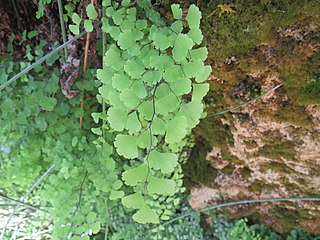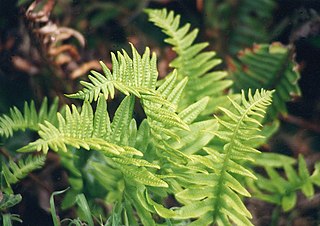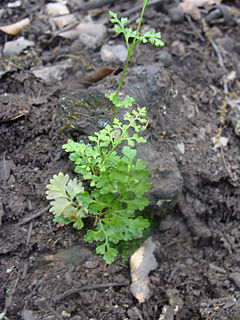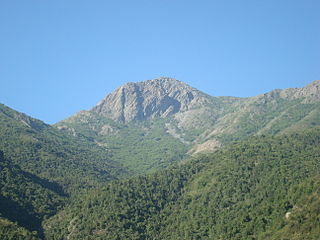
Adiantum, the maidenhair fern, is a genus of about 250 species of ferns in the subfamily Vittarioideae of the family Pteridaceae, though some researchers place it in its own family, Adiantaceae. The genus name comes from Greek, meaning "unwetted", referring to the fronds' ability to shed water without becoming wet.

Adiantum capillus-veneris, the Southern maidenhair fern, black maidenhair fern, maidenhair fern, and venus hair fern, is a species of ferns in the genus Adiantum and the family Pteridaceae with a subcosmopolitan worldwide distribution. It is cultivated as a popular garden fern and houseplant.

The order Polypodiales encompasses the major lineages of polypod ferns, which comprise more than 80% of today's fern species. They are found in many parts of the world including tropical, semitropical and temperate areas.

Pellaea is a genus of ferns in the Cheilanthoideae subfamily of the Pteridaceae. The genus name is derived from the Greek word πελλος (pellos), meaning "dark," and refers to the brown stems. Many members of the genus are commonly known as cliffbrakes. They primarily grow in rocky habitats, including moist rocky canyons, slopes, and bluffs.

Pteridaceae is a family of ferns in the order Polypodiales, including some 1150 known species in ca 45 genera, divided over five subfamilies. The family includes four groups of genera that are sometimes recognized as separate families: the adiantoid, cheilanthoid, pteridoid, and hemionitidoid ferns. Relationships among these groups remain unclear, and although some recent genetic analyses of the Pteridales suggest that neither the family Pteridaceae nor the major groups within it are all monophyletic, as yet these analyses are insufficiently comprehensive and robust to provide good support for a revision of the order at the family level.

Adiantum bellum is a species of fern in the family Pteridaceae, and is native to Bermuda.

Maytenus boaria (mayten) is an evergreen tree of the family Celastraceae, native from South America, up to 20 m (66 ft), 80 cm (31 in) diameter, straight trunk. It occurs naturally approximately from 30 to 50ºS: Chile.
Adiantum sinicum is a fern species in the Vittarioideae subfamily of the Pteridaceae. It is endemic to China. Its natural habitat is subtropical or tropical moist lowland forests. It is threatened by habitat loss.

Anogramma is a genus of ferns in the subfamily Pteridoideae of the family Pteridaceae. It contains about ten species, including:

Adiantum jordanii is a perennial species of maidenhair fern, in the Vittarioideae subfamily of the Pteridaceae. The species is known by the common name California maidenhair.

Argyrochosma is a genus of ferns known commonly as false cloak ferns. The genus is included in the Cheilanthoideae subfamily of the Pteridaceae. Species now in this genus were previously treated as members of related genera Notholaena or Pellaea but were segregated into their own genus in 1987. These ferns, of which there are about 20 species, are mostly native to the Americas, from North to South and including the Caribbean, while one species, A. connectens, is known from Sichuan, China. They are commonly found growing in cracks between rocks. Their leaves are generally shorter than 40 centimeters and have rounded bluish or grayish green segments. Often the lower surface of the segments is coated in a white dust, and the sporangia contain brown spores.

Cerro la Campana, the Bell mountain, is a mountain in La Campana National Park in central Chile. The Pacific and the mountain Aconcagua are visible from the summit on clear days.

Adiantum pedatum, the northern maidenhair fern or five-fingered fern, is a species of fern in the family Pteridaceae, native to moist forests in eastern North America. Like other ferns in the genus, the name maidenhair refers to the slender, shining black stipes.

Doodia is a genus of ferns in the family Blechnaceae, subfamily Blechnoideae, in the suborder Aspleniineae. It is named after Samuel Doody (1656-1706), an English botanist. Distribution of the genus includes parts of Australia and New Zealand.

Schizaea is a small genus of specialized ferns in the family Schizaeaceae. Common names include curlygrass fern and comb fern. Some species are very small and inconspicuous, and so may often be overlooked in nature. The genus is distinctive and not at all like the common conception of a fern, though it is still considered a true fern (leptosporangiate). The sterile fronds (trophophylls) are grass-like, and the spore-bearing fertile frond (sporophyll) is similar, but with a small, pinnate fertile segment at its apex. The upper surface of the pinnules bear the sessile capsules. Various of the roughly two dozen species have been reported from widely separated regions, including much of the tropical Old and New World, parts of the Eastern USA, Chile, the Falkland Islands, and various Pacific islands, including several islands of New Caledonia, as well as Australia and New Zealand. In Africa at least two species are endemic to South Africa.

Vittarioideae is a subfamily of the fern family Pteridaceae, in the order Polypodiales. The subfamily includes the previous families Adiantaceae and Vittariaceae.

Diphasium scariosum, synonym Lycopodium scariosum, commonly known as spreading clubmoss or creeping club moss, is a species in the club moss family Lycopodiaceae. The genus Diphasium is accepted in the Pteridophyte Phylogeny Group classification of 2016, but not in other classifications which submerge the genus in Lycopodium. D. scariosum is native to Australia, New Zealand, and Borneo.

Adiantum philippense,, also known as walking maidenhair fern, or black maidenhair, is a species of maidenhair fern (Adiantum) that is widely distributed through the southern hemisphere, notably Asia, Africa, and Madagascar.

Adiantum reniforme is a species of fern in the genus Adiantum (maidenhairs), family Pteridaceae. It grows in sheltered rock crevices and on walls. It is native to East Africa, Madagascar, Comoros and the Madeira, Canary and Cape Verde islands.
Adiantum myriosorum is a fern species very similar to Adiantum pedatum. It was once included in that species but now is recognized as being genetically distinct. It is native to Asia, from central China to northern India.

















